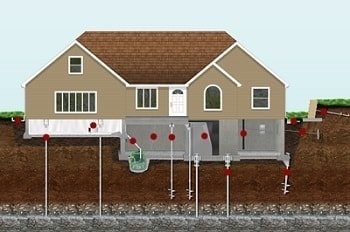Don't wait until it's too late! CALL US TODAY:
Foundation Settlement: What It Is And How To Fix It
One problem that many homeowners will eventually have to deal with is a foundation that starts to sink or settle. Foundation settlement is the downward movement of a building to a point below its original position.
We'll try to address some of the major questions about this issue and how it can affect your home.
How Common is Foundation Settlement?
In a word, very. Almost all homes deal with some amount of foundation settlement. That doesn't mean, however, that every home deals with foundation problems. The difference is the type of settlement and the amount the building settles.
A small amount of uniform settlement might cause a few hairline cracks, but no significant structural damage. When the settlement is more significant, however, and portions of the foundation settle at different rates, that is a recipe for foundation problems.
How Do We Know If Settlement Is Causing Foundation Problems
Basically, look out for the warning signs of foundation problems:
Foundation Wall & Other Cracks
Even normal settlement generally causes some cracking in foundation walls. Those cracks are usually vertical, hairline cracks.
These are generally nothing to worry about, although they should be monitored to ensure they aren't widening, which can be a sign of an ongoing issue.
Diagonal or stair step cracks, however, are often a sign of settlement-based foundation problems. These cracks, which can also emanate from openings for windows or doorways, are often a sign that settlement problems have thrown your foundation and home out of alignment, placing stress on the walls. Floor and ceiling cracks can also sometimes be seen.
Horizontal wall cracks are often related to problems other than settlement, but they can be a significant structural problem, so no matter the cause, they should be looked at by a professional.
Sticking Doors and Windows
Too much foundation settlement generally throws your foundation out of alignment. Those shifts can cause other areas of your home to lose alignment as well.
If your doors and windows are sticking, especially if they are sticking in some spots and loose in others, settlement problems could be to blame.
Tilting Chimneys
Similarly, a misaligned foundation can also make for a misaligned chimney. If your chimney is beginning to tilt, it is a good idea to look into the cause. Even if it isn't settlement, it is likely something that needs to be looked into.
Stoop Pulling Away From Home
If your stoop is beginning to pull away from your home, chances are either the stoop or the home is beginning to settle, throwing the connection between the two out of alignment.
What Causes Foundation Settlement?
Foundation settlement can be caused by several different factors, including:
- Drying and shrinking soils: Prolonged dry periods cause the soil to shrink.
- Wet and softening soils: When the soil gets overly wet, it will swell or heave. Water issues can also lead to erosion and voids, weakening the soil beneath the home.
- Poor drainage: If water is allowed to pool next to the foundation, the soil will absorb the water, causing it to heave.
- Poorly compacted fill soil: If the soil was not compacted correctly at the time of construction, the weight of the building will cause the soil to compress and the building to settle as it does.
- Maturing trees: If trees are close to the foundation, the roots will draw water from below the foundation
How Do You Fix Foundation Settlement
If problems are being caused by the foundation settlement, the solution is to raise the foundation back into alignment while also stabilizing it so the settlement problems won't recur.
 There are several different solutions to foundation settlement that contractors use, but most involve some form of underpinning. The contractors at Jerry's Waterproofing generally install steel push piers or helical piers made by renowned American foundation repair product manufacturer Earth Contact Products (ECP).
There are several different solutions to foundation settlement that contractors use, but most involve some form of underpinning. The contractors at Jerry's Waterproofing generally install steel push piers or helical piers made by renowned American foundation repair product manufacturer Earth Contact Products (ECP).
Steel push piers, also known as resistance piers, are composed of steel bars that are sunk into the ground until they hit either bedrock or a layer of soil sufficiently strong to support your home without it settling.
The home is then hydraulically lifted back to its original level or as close to it as possible. The load of the home is then transferred onto the piers, which are attached via brackets to the footing.
Helical piers work similarly, except instead of just a bar, they also include helical plates which give them the appearance of a giant screw. Instead of being sunk into the ground, helical piers are screwed in. The resistance provided by the helical plates means that helical piers often don't need to go as deep into the soil as push piers.
In either case, though, we use careful calculations and load testing to ensure that the piers are strong enough to support the weight of your home before the load is transferred onto them.
Seeking a Foundation Repair Contractor Near You in the Omaha or Lincoln, Nebraska, Areas? Contact Jerry's Waterproofing
Let the experts at Jerry's Waterproofing inspect your foundation and give you a free estimate and answer any questions you may have regarding your foundation settlement repair needs in Eastern Nebraska or Western Iowa. We have over 30 years of experience in foundation repair and basement waterproofing. Contact us today to learn more.






